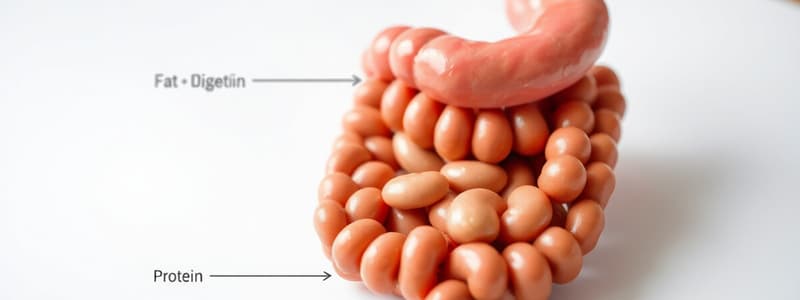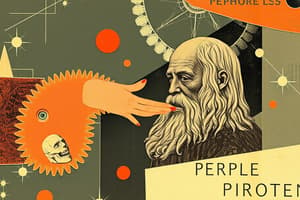Podcast
Questions and Answers
If a patient is unable to produce lipase in their pancreas, which nutrient digestion would be most directly affected?
If a patient is unable to produce lipase in their pancreas, which nutrient digestion would be most directly affected?
- Disaccharides
- Fats (correct)
- Proteins
- Carbohydrates
Which of the following represents the correct sequence of enzymatic action in protein digestion, starting in the stomach and moving to the small intestine?
Which of the following represents the correct sequence of enzymatic action in protein digestion, starting in the stomach and moving to the small intestine?
- Pepsin → Erepsin → Trypsin
- Pepsin → Trypsin → Erepsin (correct)
- Erepsin → Pepsin → Trypsin
- Trypsin → Pepsin → Erepsin
A digestive disorder prevents the proper breakdown of disaccharides. Which enzyme is most likely deficient?
A digestive disorder prevents the proper breakdown of disaccharides. Which enzyme is most likely deficient?
- Maltase/Sucrase/Lactase (correct)
- Pepsin
- Amylase
- Lipase
Why is bile essential for fat digestion even though it is not an enzyme?
Why is bile essential for fat digestion even though it is not an enzyme?
Which of the following best describes the role of enzymes in chemical digestion?
Which of the following best describes the role of enzymes in chemical digestion?
Which of the following nutrient-enzyme pairs is correctly matched with its primary site of action?
Which of the following nutrient-enzyme pairs is correctly matched with its primary site of action?
What is the final product of protein digestion that is absorbed into the villi of the small intestine?
What is the final product of protein digestion that is absorbed into the villi of the small intestine?
If the pancreas is not functioning correctly, which of the following would be most affected?
If the pancreas is not functioning correctly, which of the following would be most affected?
A patient reports that they are experiencing discomfort after consuming dairy products. Which enzyme deficiency might be the cause of their discomfort?
A patient reports that they are experiencing discomfort after consuming dairy products. Which enzyme deficiency might be the cause of their discomfort?
Considering the location where amylase is active, what would be the immediate effect on carbohydrate digestion if saliva production was severely inhibited?
Considering the location where amylase is active, what would be the immediate effect on carbohydrate digestion if saliva production was severely inhibited?
Flashcards
What does Pepsin do?
What does Pepsin do?
Breaks down long polypeptides into shorter polypeptides in the stomach.
What does Trypsin do?
What does Trypsin do?
Breaks down short polypeptides into dipeptides in the small intestine.
What does Erepsin do?
What does Erepsin do?
Breaks down dipeptides into amino acids in the small intestine.
What does Bile do?
What does Bile do?
Signup and view all the flashcards
What does Lipase do?
What does Lipase do?
Signup and view all the flashcards
What does Amylase do?
What does Amylase do?
Signup and view all the flashcards
What does Maltase/Sucrase/Lactase do?
What does Maltase/Sucrase/Lactase do?
Signup and view all the flashcards
Study Notes
- Chemical digestion involves enzymes breaking down larger molecules into smaller ones
- Each macronutrient has its own set of digestive enzymes to break it down for absorption
- Each enzyme is produced by an organ and released at the appropriate time during digestion
Protein Digestion
- Pepsin is the enzyme that catalyzes the digestion of proteins in the stomach
- Pepsin is primarily produced in the stomach
- Pepsin breaks down long polypeptides into shorter polypeptides
- Trypsin catalyzes the digestion of proteins in the small intestine and is produced in the pancreas
- Trypsin breaks down short polypeptides into dipeptides
- Erepsin catalyzes the digestion of proteins in the small intestine and is produced in the pancreas
- Erepsin breaks down dipeptides into amino acids, which are then absorbed into the villi
Fat Digestion
- Bile, which is not an enzyme, aids in mechanical digestion and is stored in the gull bladder, which is produced by the liver
- Lipase catalyzes the digestion of fats in the small intestine and is produced in the pancreas
- Lipase breaks down triglycerides (lipids) into 3 fatty acids + glycerol, which are then absorbed by the villi
Carbohydrate Digestion
- Amylase catalyzes the digestion of carbohydrates
- Amylase is primarily produced in the salivary glands and pancreas
- Amylase breaks down starch, a polysaccharide (sugar), in the mouth and small intestine into disaccharides (sucrose, maltose, lactose)
- Maltase/Sucrase/Lactase catalyzes the digestion of carbohydrates in the small intestine
- Maltase/Sucrase/Lactase is primarily produced in the small intestine
- Maltase/Sucrase/Lactase breaks down disaccharides into monosaccharides (glucose, fructose), which are then absorbed by the villi
Studying That Suits You
Use AI to generate personalized quizzes and flashcards to suit your learning preferences.




